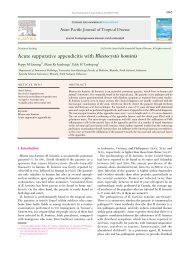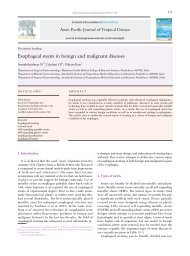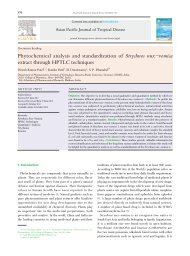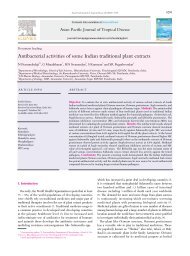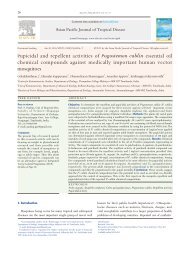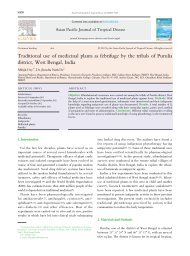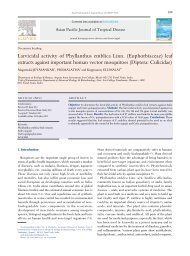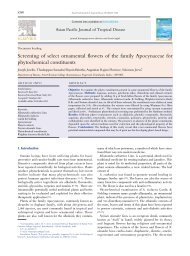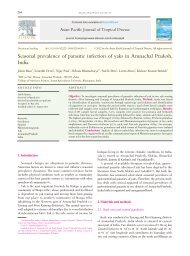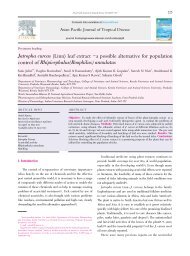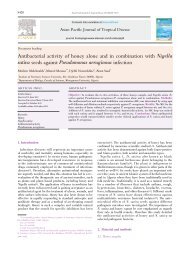Leptospirosis among zebu cattle in farms in Kaduna State, Nigeria
Leptospirosis among zebu cattle in farms in Kaduna State, Nigeria
Leptospirosis among zebu cattle in farms in Kaduna State, Nigeria
You also want an ePaper? Increase the reach of your titles
YUMPU automatically turns print PDFs into web optimized ePapers that Google loves.
Document head<strong>in</strong>g doi: 10.1016/S2222-1808(12)60080-2 襃 2012 by the Asian Pacific Journal of Tropical Disease. All rights reserved.<br />
<strong>Leptospirosis</strong> <strong>among</strong> <strong>zebu</strong> <strong>cattle</strong> <strong>in</strong> <strong>farms</strong> <strong>in</strong> <strong>Kaduna</strong> <strong>State</strong>, <strong>Nigeria</strong><br />
Emmanuel Ochefije Ngbede 1*<br />
, Mashood Abiola Raji 1 , Clara N. Kwanashie 1 , Emmanue l Chukwudi Okolocha 2 , Nanven<br />
Abraham Maurice 3 , Emmanuella Nguavese Akange 4 , Leslie Ewache Odeh 2<br />
1<br />
Department of Veter<strong>in</strong>ary Pathology and Microbiology, Faculty of Veter<strong>in</strong>ary Medic<strong>in</strong>e, Ahmadu Bello University, Zaria, P.M.B 1069 Zaria,<br />
<strong>Kaduna</strong> <strong>State</strong>, <strong>Nigeria</strong><br />
2<br />
Department of Veter<strong>in</strong>ary Public Health and Preventive Medic<strong>in</strong>e, Faculty of Veter<strong>in</strong>ary Medic<strong>in</strong>e, Ahmadu Bello University, Zaria, P.M.B 1069<br />
Zaria, <strong>Kaduna</strong> <strong>State</strong>, <strong>Nigeria</strong><br />
3<br />
<strong>Nigeria</strong>n Veter<strong>in</strong>ary Research Institute (NVRI) South-South Zonal Laboratory, Calabar, Cross River <strong>State</strong>, <strong>Nigeria</strong><br />
4<br />
Department of Veter<strong>in</strong>ary Pathology and Microbiology, University of Agriculture Makurdi, P.M.B. 2373 Makurdi, Benue <strong>State</strong>, <strong>Nigeria</strong><br />
ARTICLE INFO ABSTRACT<br />
Article history:<br />
Received 15 July 2012<br />
Received <strong>in</strong> revised form 27 July 2012<br />
Accepted 28 October 2012<br />
Available onl<strong>in</strong>e 28 October 2012<br />
Keywords:<br />
Cattle<br />
ELISA<br />
Farms<br />
<strong>Leptospirosis</strong><br />
Leptospira hardjo<br />
<strong>Nigeria</strong><br />
Prevalence<br />
Zebu breeds<br />
1. Introduction<br />
Asian Pac J Trop Dis 2012; 2(5): 367-369<br />
Asian Pacific Journal of Tropical Disease<br />
<strong>Leptospirosis</strong> is an economically important zoonotic<br />
disease caused by a spirochaete bacterium of the genus<br />
Leptospira[1]. The <strong>cattle</strong> ma<strong>in</strong>eta<strong>in</strong>ed Leptospira spp. serovar<br />
Hardjo consist of two serologically <strong>in</strong>dist<strong>in</strong>guishable but<br />
genetically dist<strong>in</strong>ct species; Leptospira <strong>in</strong>terrogans serovar<br />
Hardjo and Leptospira borgpetersenii serovar Hardjo.<br />
Cattle-ma<strong>in</strong>ta<strong>in</strong>ed leptospires of the serovar Hardjo are<br />
the major cause of bov<strong>in</strong>e leptospirosis[2]. This <strong>in</strong>fection<br />
is responsible for considerable f<strong>in</strong>ancial loss to the <strong>cattle</strong><br />
<strong>in</strong>dustry as a consequence of agalactia, abortion, stillbirth,<br />
birth of weak calves and reduced fertility[3,4]. The diagnosis<br />
of leptospirosis is commonly based on the demonstration<br />
of antibodies by serological test. Though <strong>in</strong> spite of its<br />
disadvantages, microscopic agglut<strong>in</strong>ation test (MAT) is<br />
still the gold standard serological test for the diagnosis<br />
of leptospirosis[5]. Other serological test such as enzyme<br />
l<strong>in</strong>ked immunosorbent assay (ELISA) has been employed<br />
*Correspond<strong>in</strong>g author: Ochefije Ngbede, Department of Veter<strong>in</strong>ary Pathology and<br />
Microbiology, Faculty of Veter<strong>in</strong>ary Medic<strong>in</strong>e, Ahmadu Bello University, Zaria, P.M.B<br />
1069 Zaria, <strong>Kaduna</strong> <strong>State</strong>, <strong>Nigeria</strong>.<br />
Tel: +2348065484070<br />
E-mail: drngbede@hotmail.com<br />
Contents lists available at ScienceDirect<br />
journal homepage:www.elsevier.com/locate/apjtd<br />
367<br />
Objective: To assess the occurrence of Leptospira spp serovar Hardjo <strong>among</strong> Zebu <strong>cattle</strong> <strong>in</strong><br />
some livestock produc<strong>in</strong>g areas of <strong>Kaduna</strong> <strong>State</strong>, <strong>Nigeria</strong>. Methods: Sera samples were obta<strong>in</strong>ed<br />
from 164 Zebu breed of <strong>cattle</strong> above one year osf age <strong>in</strong> seven <strong>cattle</strong> <strong>farms</strong> were screened for<br />
antibodies to Leptospira spp. serovar Hardjo us<strong>in</strong>g Enzyme l<strong>in</strong>ked immunosorbent assay (ELISA).<br />
Results: Antibodies to Leptospira spp. serovar Hardjo were detected <strong>in</strong> eighteen (10.98%) out of<br />
the 164 animals sampled. There was no significant difference (P>0.05) <strong>in</strong> seropositivity between<br />
the different age groups or between different Zebu breeds. Conclusions: The presence of<br />
<strong>Leptospirosis</strong> <strong>among</strong> the Zebu breeds of <strong>cattle</strong> may poses a threat to livestock production and has<br />
public health implication due to its zoonotic potential.<br />
as a useful alternative. It is a reliable test and gives good<br />
results <strong>in</strong> diagnosis that has correlation with those of MAT<br />
In spite of reports of the occurrence of leptospirosis <strong>in</strong> <strong>cattle</strong><br />
worldwide and economic importance due to reproductive<br />
problems and overall impaired productivity, few studies<br />
have been conducted to assess its occurrence <strong>in</strong> <strong>cattle</strong><br />
population <strong>in</strong> <strong>Nigeria</strong> and non after the work of Diallo about<br />
three decade ago especially <strong>in</strong> <strong>Kaduna</strong> <strong>State</strong>[7]. The <strong>in</strong>tention<br />
of this study was therefore, to <strong>in</strong>vestigate the occurrence of<br />
the disease <strong>among</strong> Zebu <strong>cattle</strong>.<br />
2. Materials and methods<br />
Blood samples were collected from thirty percent of the<br />
total number of <strong>zebu</strong> <strong>cattle</strong> <strong>in</strong> each of seven <strong>farms</strong> located<br />
<strong>in</strong> Sabon Gari, Giwa and Zaria Local government areas<br />
of <strong>Kaduna</strong> <strong>State</strong>, <strong>Nigeria</strong> based on the world organisation<br />
for Animal Health recommendation of at least 10% of<br />
animals <strong>in</strong> a herd[5]. The sampl<strong>in</strong>g area is located between<br />
latitudes 11°7’-11°12’N and longitudes 07°41’E. The area<br />
is characterized by a tropical climate; a mean monthly<br />
temperature of 13.8-36.7 曟 and annual ra<strong>in</strong>fall of 1092.8<br />
mm[8].<br />
Blood samples were collected from a total of one 164
368<br />
<strong>in</strong>digenous breeds of <strong>cattle</strong> (Whie Fulani, Sokoto Gudali and<br />
Rahaji) on the seven <strong>farms</strong> via venipuncture of the jugular<br />
ve<strong>in</strong> <strong>in</strong>to anticocoagulant free labelled sample bottles. Only<br />
animals above one year of age were sampled. The animals<br />
were aged us<strong>in</strong>g their dentition. Sera was separated by<br />
centrifugation of the clotted blood at 4 000 r/m<strong>in</strong> for 5 m<strong>in</strong><br />
and stored at -20 曟 until use.<br />
ELISA kit obta<strong>in</strong>ed from L<strong>in</strong>nodee Animal Care,<br />
Ballyclare, Ireland was used to screen the sera for<br />
antibodies to Leptospira spp. serovar Hardjo. The ELISA<br />
kit has a sensitivity of 94.10%, a sensitivity of 94.80% and a<br />
Kappa <strong>in</strong>dex of 0.9. The ELISA was performed as described<br />
by the Scolamacchia et al and recommended by the<br />
manufacturer[9]. Briefly, positive and negative controls were<br />
diluted at 1:50 dispensed <strong>in</strong>to duplicate wells on each plate.<br />
Sera were also diluted 1:50 <strong>in</strong> the kit diluents and 100ml<br />
was dispensed to each well. The plates were <strong>in</strong>cubated for<br />
40 m<strong>in</strong>utes <strong>in</strong> the <strong>in</strong>cubator at 37 曟, and then washed four<br />
times with the buffer provided alongside the kit. 100 毺L of<br />
the conjugate (HRP) was added to each of the wells and the<br />
plates <strong>in</strong>cubated at 37 曟 for 40 m<strong>in</strong>, after which the plates<br />
were washed four times with the appropriate buffer. 100 毺<br />
L of the substrate (TMB-E) was then added to each well and<br />
the plate <strong>in</strong>cubated at room temperature for 10 m<strong>in</strong>, after<br />
which 50 毺L of the stop solution was then added to each well<br />
and the plates read us<strong>in</strong>g an ELISA reader at 450. The test<br />
results were expressed as a ratio of samples value related to<br />
positive control value (S/P) us<strong>in</strong>g the formula:<br />
S/P=<br />
Mean sample optical density-Mean negative control optical density<br />
Mean positive control optical density-Mean negative control<br />
optical density<br />
Cattle whose serum has an S/P greater than 0.12 were<br />
considered seropositive, while titre plates with negative<br />
control sera optical density of above 0.25 was considered<br />
<strong>in</strong>valid.<br />
Data obta<strong>in</strong>ed were presented <strong>in</strong> form of tables and<br />
analysed us<strong>in</strong>g Fisher’s exact test with the aid of the SPSS<br />
(version 17.0). P 5 years were respectively seropositive for<br />
Leptospira hardjo. There was no statistically significant<br />
difference <strong>in</strong> seropositivity of leptospirosis between different<br />
the age groups. Based on <strong>in</strong>dividual breeds prevalences;<br />
13 (9.92%) White Fulani and 5 (17.24%) Sokoto Gudali were<br />
seropositive for Leptospira hardjo while none of the Rahaji<br />
Emmanuel Ochefije Ngbede et al./Asian Pac J Trop Dis 2012; 2(5): 367-369<br />
breed was seropositive for Leptospira hardjo. There was<br />
no statistically significant difference <strong>in</strong> seropositivity of<br />
leptospirosis between the different breeds (Table 3).<br />
Table 1.<br />
Sex, age and breed distribution of <strong>zebu</strong> <strong>cattle</strong> <strong>in</strong> the different <strong>farms</strong>.<br />
Farms A B C D E F G Total (%)<br />
Sex<br />
Males 2 3 0 8 10 1 9 33 (20.12)<br />
Females 20 30 16 12 27 8 18 131 (79.88)<br />
Age<br />
5 15 22 6 13 35 6 18 115 (70.12)<br />
Breeds<br />
Sokoto Gudali 9 16 0 0 0 2 2 29 (17.68)<br />
Rahaji 2 2 0 0 0 0 0 4 (2.44)<br />
White Fulani 11 15 16 20 37 7 25 131 (79.88)<br />
Table 2.<br />
Prevalence rate of leptospirosis <strong>in</strong> Zebu <strong>cattle</strong> <strong>in</strong> the different <strong>farms</strong>.<br />
Farms A B C D E F G Total<br />
Total number of<br />
animals sampled<br />
22 33 16 20 37 9 27 164<br />
Number of animals<br />
seropositive<br />
6 10 1 0 0 1 0 18<br />
Prevalence (%) 22.27 30.30 6.25 - - 11.11 - 10.98<br />
Table 3.<br />
Sex, Age and Breed prevalence of leptospirosis <strong>among</strong> the Zebu <strong>cattle</strong>.<br />
Variables Total no.<br />
of animals<br />
sampled<br />
No. of<br />
animals<br />
seropositive<br />
Prevalence<br />
(%)<br />
P value<br />
Sex 0.0252<br />
Males 33 (20.12) 0 -<br />
Females 131 (79.88) 18 13.74<br />
Age (year) 0.3719<br />
< 2 26 (15.85) 1 3.85<br />
2-5 23 (14.02) 2 8.70<br />
>5 115 (70.12) 15 13.04<br />
Breeds 0.4052<br />
Sokoto Gudali 29 (17.68) 5 17.24<br />
Rahaji 4 (2.44) 0 -<br />
White Fulani 131 (79.88) 13 9.92<br />
4. Discussion<br />
Leptospira spp. serovar Hardjo antibodies were detected<br />
<strong>in</strong> the Zebu <strong>cattle</strong> with a prevalence of 10.98%. Cattle are not<br />
rout<strong>in</strong>ely vacc<strong>in</strong>ated aga<strong>in</strong>st leptospirosis <strong>in</strong> <strong>Nigeria</strong> and<br />
none of the <strong>farms</strong> sampled had reportedly vacc<strong>in</strong>ated their<br />
<strong>cattle</strong> aga<strong>in</strong>st leptospirosis[8]. All animals sampled were<br />
above one year of age, thereby rul<strong>in</strong>g out cross-reactions or<br />
<strong>in</strong>terference by maternal antibodies. Therefore, the presence<br />
of Leptospiral antibodies <strong>in</strong> these animals is suggestive of<br />
natural exposure to the organism.<br />
Bov<strong>in</strong>e leptospirosis has been previously reported <strong>among</strong><br />
<strong>cattle</strong> <strong>in</strong> other parts of <strong>Nigeria</strong>[7,10-13]. Although, the Zebu<br />
<strong>cattle</strong> <strong>in</strong> the current study were tested for antibodies aga<strong>in</strong>st<br />
Leptospira spp. serovar Hardjo as opposed to cultural<br />
isolation, some <strong>in</strong>fected animals have been reported to
ema<strong>in</strong> so for life and cont<strong>in</strong>ue to shed the organism[14-17].<br />
It is therefore, likely that the seropositive animals are still<br />
shedd<strong>in</strong>g the organism.<br />
Though, cows had a higher (13.74%) prevalence of the<br />
disease compared to males where none was positive. The<br />
presence of statistically significant difference (P5 had more seropositive animals<br />
(12.50%) compared to the other age groups, this does not<br />
necessarily <strong>in</strong>dicate that the older animals are at higher risk<br />
of <strong>in</strong>fection by the organism but may be a reflection of the<br />
long duration/persistence of antibodies aga<strong>in</strong>st the organism<br />
and more exposure time. This is supported by the absence of<br />
statistically significant difference (P 0.05) <strong>in</strong> seropositivity across<br />
the three breeds <strong>in</strong>dicat<strong>in</strong>g they all face the same risk of<br />
<strong>in</strong>fection by Leptospira species. The low number of the<br />
Sokoto Gudali and Rahaji breeds compared to the White<br />
Fulani breed which are the most common breed <strong>in</strong> this area<br />
and the country at large may have contributed to the high<br />
number of seropositive animals <strong>among</strong> the White Fulani<br />
breed. Zebu breeds are commonly purchased from herdsmen<br />
or <strong>cattle</strong> marketers for stock<strong>in</strong>g of new <strong>farms</strong> or restock<strong>in</strong>g<br />
of old <strong>farms</strong>. They are then cross bred with exotic breeds to<br />
produce offspr<strong>in</strong>g with greater vigour and characteristics<br />
desired by the farmer. The presence therefore, of this disease<br />
<strong>among</strong> the Zebu <strong>cattle</strong> implies an impend<strong>in</strong>g economic<br />
loss to the farmers who <strong>in</strong>tends to use these animals for<br />
crossbreed<strong>in</strong>g as Leptospira spp. serovar Hardjo has been<br />
reported to cause agalactia, abortion, stillbirth, birth of weak<br />
calves and reduced fertility asides it zoonotic potential[3, 4].<br />
The f<strong>in</strong>d<strong>in</strong>gs of this study <strong>in</strong>dicate that the leptospirosis is<br />
present <strong>among</strong> Zebu <strong>cattle</strong> despite the paucity of reports<br />
on cl<strong>in</strong>ical cases. Therefore, the close contact and cohabitation<br />
that exists between some of the farm workers and<br />
<strong>cattle</strong> may result <strong>in</strong> the spread of this zoonosis.<br />
The f<strong>in</strong>d<strong>in</strong>gs of these study suggests the need for<br />
enlightenment of livestock health workers especially<br />
veter<strong>in</strong>arians on the need to <strong>in</strong>clude leptospirosis <strong>among</strong> the<br />
diseases to be screened for before addition of new animals<br />
<strong>in</strong>to a herd.<br />
Conflict of <strong>in</strong>terest statement<br />
We declare that we have no conflict of <strong>in</strong>terest.<br />
References<br />
[1] Adler B, Lo M, Seemann T, Murray GL. Pathogenesis of<br />
Emmanuel Ochefije Ngbede et al./Asian Pac J Trop Dis 2012; 2(5): 367-369 369<br />
leptospirosis: The <strong>in</strong>fluence of genomics. Vet Microbiol 2011;<br />
153(1-2): 73-81.<br />
[2] Tabatabaeizadeh E, Tabar GH, Farzaneh N, Seifi HA. Prevalence<br />
of Leptospira hardjo antibody <strong>in</strong> bulk tank milk <strong>in</strong> some dairy<br />
herds <strong>in</strong> Mashhad suburb. Afri J Microbiol Res 2011; 5(14):<br />
1768-1772.<br />
[3] Van De Weyer L, Hendrick, S, Rosengren L, Waldner CL.<br />
<strong>Leptospirosis</strong> <strong>in</strong> beef herds from western Canada: Serum antibody<br />
titers and vacc<strong>in</strong>ation practices. Can Vet J 2011; 52(6): 619626.<br />
[4] Doosti A, Hoveizeh HN. Diagnosis of Leptospiral abortion <strong>in</strong> bov<strong>in</strong>e<br />
by polymerase cha<strong>in</strong> reaction. Global Veter<strong>in</strong>aria 2011; 7(1): 79-82.<br />
[5] Office International des Epizooties. World Organisation for animal<br />
health. Manual of standards for diagnostic tests and vacc<strong>in</strong>es.<br />
2008.<br />
[6] Shekatkar SB, Harish BN, Menezes GA, Parija SC. Cl<strong>in</strong>ical and<br />
serological evaluation of leptospirosis <strong>in</strong> Puducherry, India. J<br />
Infect Dev Ctries 2010; 4(3): 139-143.<br />
[7] Diallo AA. Public health significance of leptospirosis <strong>in</strong> northern<br />
<strong>Nigeria</strong> (PhD thesis). <strong>Nigeria</strong>: Ahmadu Bello University, Zaria;<br />
1978, p. 234<br />
[8] Agbogu VN, Umoh VJ, Okuofu CA, Smith SI, Ameh JB. Study of<br />
the bacteriological and physicochemical <strong>in</strong>dicators of pollution<br />
of surface waters <strong>in</strong> Zaria, <strong>Nigeria</strong>. Afr J Biotechnol 2006; 5(9):<br />
732-737.<br />
[9] Scolamacchia F, Handel IG, Fèvre EM, Morgan KL, Tanya VN,<br />
Bronsvort BMD. Serological patterns of brucellosis, ;eptospirosis<br />
and Q fever <strong>in</strong> Bos <strong>in</strong>dicus Cattle <strong>in</strong> Cameroon. PLoS ONE 2010;<br />
5(1): e8623.<br />
[10] Agunloye CA, Ogundipe GAT, Ajala OO. Serological<br />
bacteriological exam<strong>in</strong>ation of slaughtered <strong>cattle</strong> for leptospirosis<br />
<strong>in</strong> Ibadan, <strong>Nigeria</strong>. Bull Anim Hlth Prod 1997; 48: 45-48.<br />
[11] Ezeh AO, Addo PB, Adesiyun AA Lawande RV. Leptospiral<br />
antibody reponses <strong>in</strong> four <strong>cattle</strong> herds <strong>in</strong> Plateau <strong>State</strong> of <strong>Nigeria</strong>.<br />
Bull Anim Hlth Prod 1987; 53(3): 263-265.<br />
[12] Ezeh AO, Addo PB, Adesiyun AA, Bello CSS, Mak<strong>in</strong>de AA.<br />
Serological prevalence of bov<strong>in</strong>e leptospirosis <strong>in</strong> Plateau <strong>State</strong>,<br />
<strong>Nigeria</strong>. Elev Med Vet Pays Trop 1989; 42: 505-508.<br />
[13] Agunloye CA, Adeniyi AI, Aremu ON, Oladeji JO, Ojo MO,<br />
Ogundipe GAT. An evaluation of an IgG ELISA for the diagnosis of<br />
bov<strong>in</strong>e leptospirosis. Bull Anim Hlth Prod 2000; 48: 45-48.<br />
[14] Zuerner RL, Alt DP, Palmer MV, Thacker TC, OlsenSC. A<br />
Leptospira borgpetersenii serovar Hardjo vacc<strong>in</strong>e <strong>in</strong>duces a Th1<br />
response, activates NK cells, and reduces renal colonization. Cl<strong>in</strong><br />
Vacc<strong>in</strong>e Immunol 2011; 18(4): 684-691.<br />
[15] Shafighi1 T, Abdollahpour G, Salehi ZT, Tadjbakhsh H. Serological<br />
and bacteriological study of leptospirosis <strong>in</strong> slaughtered <strong>cattle</strong> <strong>in</strong><br />
north of Iran (Rasht). Afr J Microbiol Res 2010; 4(20): 2118-2121.<br />
[16] Victoriano AFB, Smythe LD, Gloriani-Barzaga N, Cav<strong>in</strong>ta LL,<br />
Kasai T, Khanchit LK, et al. <strong>Leptospirosis</strong> <strong>in</strong> the Asia Pacific<br />
region. BMC Infect Dis 2009; 9: 147.<br />
[17] Bharti AR, Nally DE, Ricaldi JN, Mattias MA, Diaz MM, Lovett<br />
MA, et al. <strong>Leptospirosis</strong>: a zoonotic disease of global importance.<br />
Lancet Infect Dis 2003; 3(12): 757-71.<br />
[18] Taiwo BAA, Olaniran ODD, Aluko FA. Breed and environmental<br />
factors Affect<strong>in</strong>g body measurements of beef <strong>cattle</strong> <strong>in</strong> Yewa,<br />
<strong>Nigeria</strong>. Agric J 2010; 5(3): 211-214.<br />
[19] Adama JY, Shiawoya EL, Michael N. Incidence of foetal wastages<br />
of cows slaughtered <strong>in</strong> M<strong>in</strong>na abattoir. J Appl Biosci 2011; 42:<br />
2876-2881.<br />
[20] Khalili M, Sakhaee E, Aflatoonian MZ, Shahabi-Nejad N. Herd–<br />
prevalence of Coxiella burnetii (Q fever) antibodies <strong>in</strong> dairy <strong>cattle</strong><br />
<strong>farms</strong> based on bulk tank milk analysis. Asian Pac J Trop Med<br />
2011; 4(1): 58-60.



